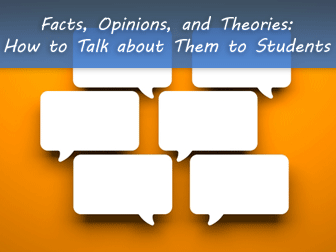Facts, Opinions, and Theories: How to Talk about Them to Students


- Did aliens land in New Mexico in 1947?
- What really happened to Princess Diana?
- Can we be sure we didn’t misinterpret the Maya calendar’s predictions about 2012?
Here is an exercise which covers all the bases. All four skills are practiced, the students work in teams, and there is the need for persuasion, creativity, debate, comparison, the use of the modals and conditionals, AND some useful new vocabulary.
Almost everyone is familiar with the standard conspiracy theories of our time, and most of us have opinions about one or more of them, whether frankly dismissive or mildly curious. Without encouraging your students to take seriously such unscientific mindlessness as the ‘Apollo moon landing hoax’, teachers can embrace the great practice opportunities offered by conspiracy theories. Here’s a set of recommended steps for using these theories in the classroom.

How many conspiracy theories can the students name? Check some general knowledge while they brainstorm: can they tell you JFK’s full name? Do they know which state Roswell is in? Can they name any movies with Marilyn Monroe, or the two men accused of shooting the Kennedy brothers, or the names of moon walkers?
Invite the students to establish how much credibility their classmates give to each theory. They could use a scale of one to ten, but this is also the first opportunity to practice modal verbs. A review session might help. Encourage, “It can’t possibly be true,” instead of, “It’s not true”, and replace, “Maybe not...” with “It might not be...”
Get feedback and discover which theories are given the most and least credence. Are any of the results surprising?
Invite the students to prepare a short presentation on one of these theories. How did the theory arise? Who has been peddling it? Is there research on how seriously is it taken by the public? What are the main selling points, or main drawbacks of each theory? Ask the students to research only to the level that their classmates would need to come to their own basic conclusions about the theory. Perhaps also invite the team to give their own opinion at the end of their short presentation.
Here’s where the teacher can get really creative. Choose a topic area and create your own scenario from which a conspiracy theory might emerge. Some of the best examples have come from fictional celebrity deaths or corrupt business or political dealings. Here’s a synopsis of my favorite:
An Oscar-winning actress is found dead in her hotel room at the age of 36. No cause of death can immediately be established, but she had a recent and very public falling out with her husband who, in some circles, is accused of abusing her. Although her physician had been prescribing anti-depressants, she did not appear particularly low the last time he saw her. The actress’ agent, who has mysteriously vanished, had just signed a massive publishing deal for a book about the star. She is suspected in some circles of funding a radical environmental terrorist organization who target oil company assets, and the police or CIA might have been investigating her. The actress’ will leaves a surprising amount of money to her first husband, who is despised by her current husband. How exactly might she have died?
My students created some compelling theories to explain the actress’ untimely demise.
Whatever the students choose to do, their theory should be readily believable, and should not rely on evidence we don’t yet have.
This is best done in teams, requiring the students to organize their theory in advance and distribute sections of the speaking to each team member.
The students will find themselves switching between past and modal forms (i.e. “She was murdered by...” versus, “She might have been murdered by...”, and expressing levels of likelihood in detail: “She might have been under surveillance...”; “Her husband could well have...”; “Her agent couldn’t possibly have...”; “Would a physician ever do such a thing?”
Persuasive language will also be useful: “You have to agree that...”; “It’s not difficult to connect this to...”; “Only a fool would believe that...”
The class might conclude with a vote for the most convincing or original theory. Before the vote, ask students to summarize the theories of the other teams; this is a listening check, as well as a useful review of the theories. After voting, perhaps try to establish why the winner succeeded, and what the other theories might have lacked?
There are abundant opportunities for writing assignments based on conspiracy theories.